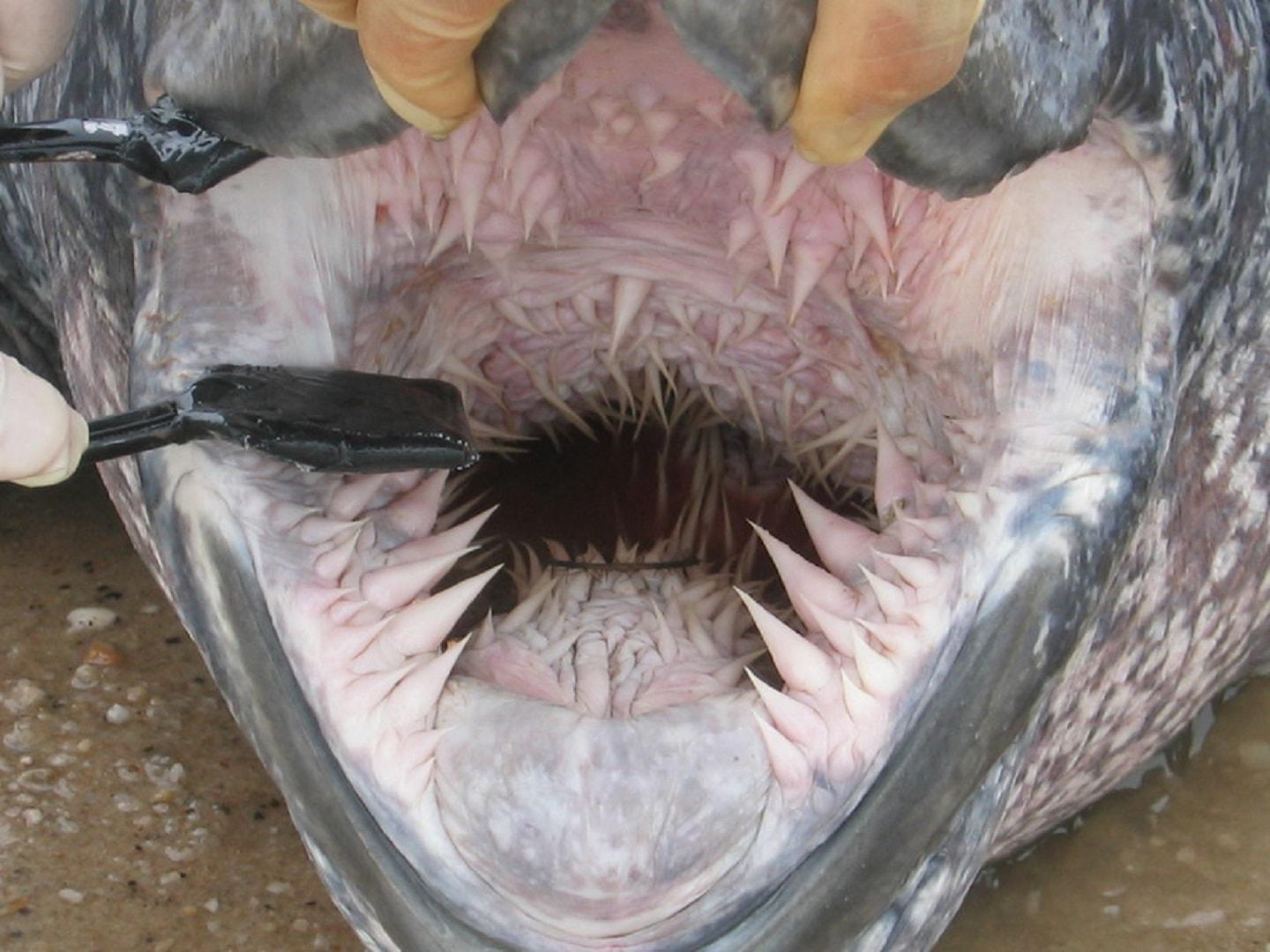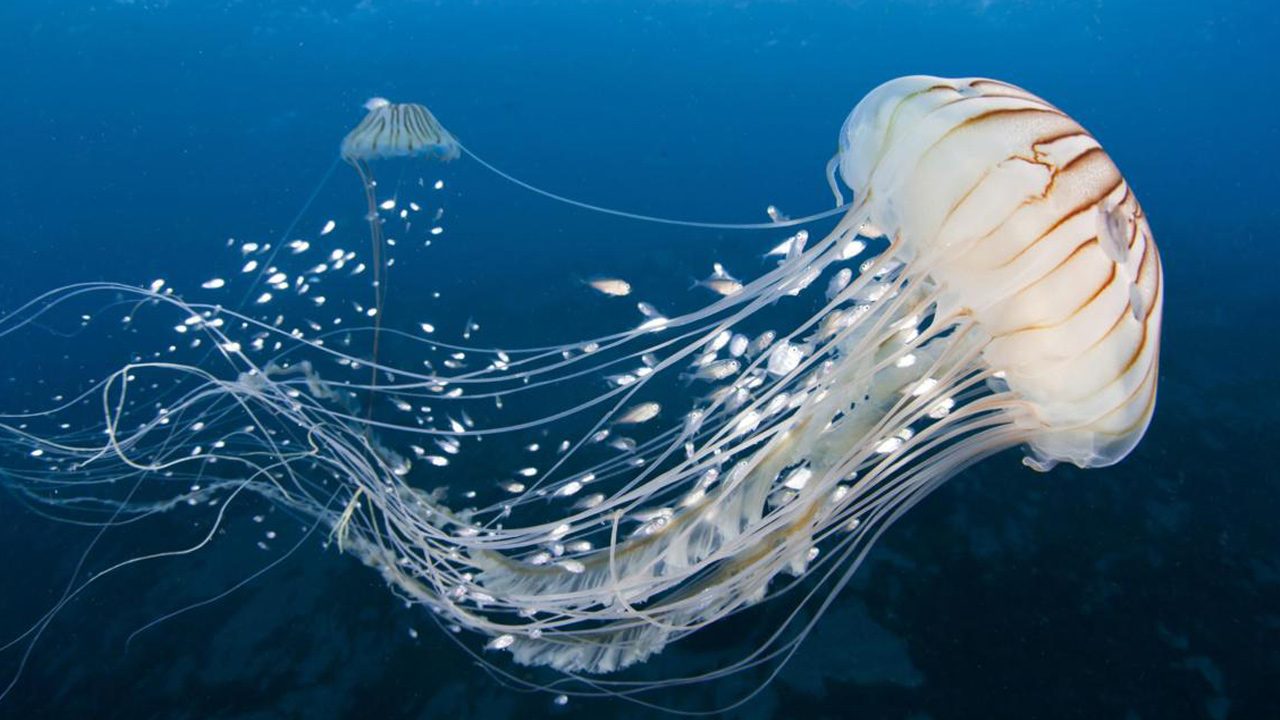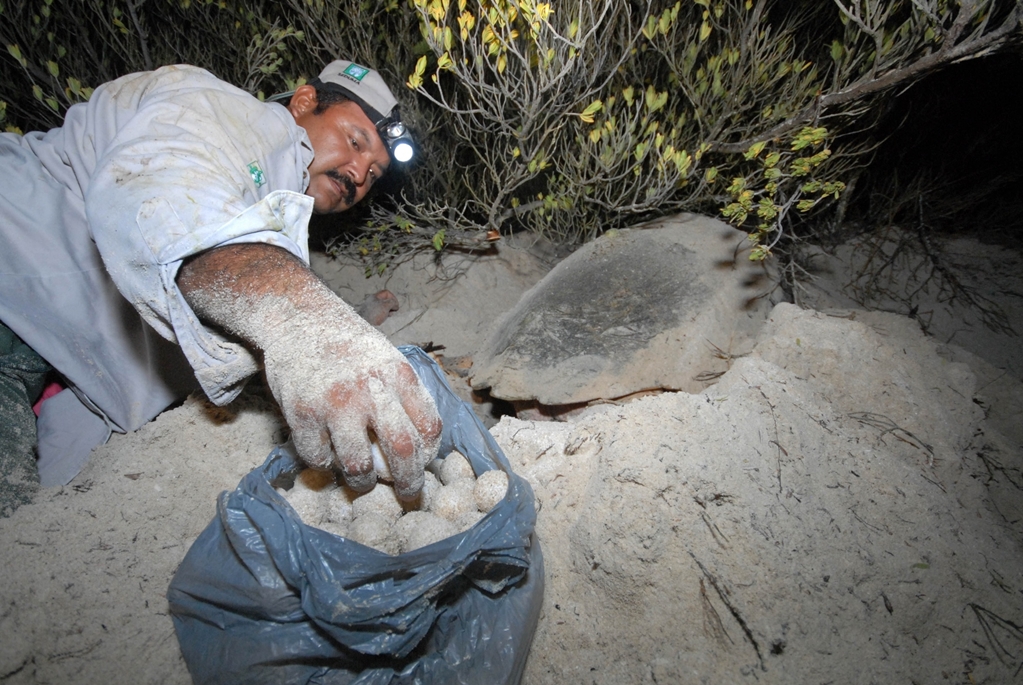La Leatherback Turtle, is a species of reptile that corresponds to the largest of sea turtles. It does not have a bony shell, it can measure more than 2 meters in length and its weight exceeds 900 kilograms. It is located in practically all the oceans and being able to discover it is a wonderful journey.

Leatherback Turtle
La leatherback sea turtle, scientifically known under the name of “Dermochelys coriacea”, is biologically classified as a dermochelid reptile, of the Dermochelyidae family. It is known that of its genus Dermochelys, it is currently the only survivor. Throughout Latin America it is identified with the names of leatherback turtle, leatherback, canaá, cardón or leatherback, among others.
It should be noted that of the registered sea turtles, this is the one that develops a greater length and weight. Where records have confirmed measurements of lengths greater than 2 meters. As well as weights greater than 900 kilograms, both in males.
Which makes it the fourth reptile with the largest dimension, after the first three places were occupied by its crocodile relatives:
- Saltwater Crocodylus pososus.
- Of the Nile (Crocodylus niloticus).
- And Orinoco (Crocodylus intermedius).
The average weight of the leatherback turtle is normally around 600 kilograms. Regarding its development, it is characterized by being present in all oceans, preferring tropical, subtropical and subpolar seas. Characterized by being a migratory species capable of traveling unthinkable distances at high speed and against the current.
In addition, surprisingly, scientists have the opinion that it has the ability to generate its own body heat. Because it has the peculiarity of maintaining a body temperature of 18 ° C higher than the temperature of the water where it is.
As for his threat level, that is, Species extinction, the leatherback turtle, according to the International Union for Conservation of Nature or IUCN. It is classified in the “Red List” of extinction, under the category of “Vulnerable”. In which man and his behavior represent his main risk.
Where does your name come from?
When observing what it has for its shell, which is not bone, but only a layer of tissue or skin and fat, in which seven salient lines marked along this layer are clearly differentiated. It is reminiscent of what the lute describes, which is a musical instrument of Arab origin.
This instrument, moreover, is provided with an oval box, with a short neck and strings to be plucked. Being then all this set of characteristics or appearance, which has surprisingly given the name to this peculiar sea turtle.
Taxonomic Classification of the Leatherback Sea Turtle
In this sense, the taxonomic classification is one that is responsible for scientifically qualifying all existing living beings. Being essential for this, to categorize their similarities, as well as the phylogenetic proximity. Having then that for the leatherback sea turtle, according to the French naturalist, zoologist and anatomist Henri Marie Ducrotay de Blainville, in the year 1816, its classification is as follows:
- Animalia Kingdom
- Edge: Chordata
- Class: Sauropsida
- Order: Testudines
- Suborder: Cryptodira
- Family: Dermochelyidae
- Genus: Dermochelys
From which its species of "Dermochelys coriacea", comes from previous years by the Italian naturalist, Domenico Agostino Vandelli, exactly from 1761.
Habitat of these Turtles
La leatherback sea turtle, has the virtue of being found in practically all oceans, showing that it can be in water with a warm temperature. As in a very low temperature water, without this being or representing an instability in its usual behavior.
It is common to locate it in tropical, subtropical and subpolar seas. Therefore, it is cataloged as the one with the greatest distribution. On the contrary, it is not easy to be sighted, because they rarely approach the surface, being the main preference the depths, normally more than 1.000 meters towards the bottom.
It should be noted that its continuous maintenance of body heat is what makes it possible for it to develop in this way, cataloging itself as the only reptile that maintains an active behavior at a temperature below 40 degrees Fahrenheit or 4,44 degrees Celsius.
Leatherback Turtle Characteristics
This powerful reptile is distinguished by having the following characteristics, which are:
- Both its skin and its "non-bony" shell are black or dark gray, with whitish or light pink spots. Bearing that this color expands from its head to its rear fins.
- The hard skin layer (shell) is thin and rubbery, armored by thousands of small bony plates.
- It has two immense front fins that can measure up to an average of 2,7 meters in length, from end to end, in the most prominent males.
- Its front fins do not have claws or scales and its rear fins have a particular paddle shape.
- What looks like the shell of the leatherback sea turtle is simply skin and fat, provided with seven well-accentuated keels or divisions.
- It can reach a length of 2,3 meters and weigh up to approximately 900 kilograms.
- The leatherback turtle does not have teeth, but very sharp edges or cusps directed towards the back, very similar to thorns. That helps him, both to take the marine plants and to hold his prey until he eats them completely.
- Its throat has barbs that point inwards, which makes it easier for it to finish swallowing the food.
Other Notable Features
Apart from the characteristics already indicated, there are the following, which also have relevance to mention, these are:
- It differs by being the fastest reptile.
- The peculiar shape of his body is what allows him to move at high speed, as well as against the current.
- It dives to a depth of 1.280 meters, staying underwater for a total of 85 minutes. Going out only to take a breath whenever he feels the need during that time or when he approaches the limit of endurance.
- It is presumed that the leatherback turtle has a longevity that ranges around 80 years, but this value is only an assumption because until now such figure is unknown with accuracy. On the other hand, there are those who affirm that he lives up to 30 years, in itself, the reality of his average age is a mystery.
- The leatherback sea turtle has the extraordinary virtue of being found in practically all oceans, preferring tropical, subtropical and subpolar waters or seas.
- Currently, it is the only survivor of its genus Dermochelys.
- It is characterized by being able to maintain its body temperature with 18 ° C above the temperature of the water where it is.
- It is part of the animals that migrate, showing total aptitude to travel unthinkable distances.
- The males never come ashore, while the females only do so when they are about to lay their eggs. Being a nocturnal behavior, to later return to the sea.
Leatherback Turtle Feeding
Because the leatherback sea turtle It has a delicate jaw, its food preference is based on jellyfish or jellyfish, which have a gelatinous body. As well as numerous marine algae.
Apart from these, or as a complementary diet, it has secondary options among which are:
- Little fishes.
- Crustaceans, such as crabs, prawns, shrimp, and barnacles.
- Sea urchins.
- Snails.
- Calamari, among others.
From which we have the data, that in a single day it manages to eat its own weight in jellyfish, which means that it could eat up to 50 of these marine animals. Which obviously helps in the ecological balance, because by maintaining it, it is possible to conserve fishing.
Remembering that jellyfish are responsible for eating small fish, thus causing in the future that there is not enough to fish. But this does not happen thanks to the intervention and nutritional needs of the leatherback turtle, which eats a substantial amount of these daily.
Reproduction of this Species
It should be noted that the reproductive age, that is, in which the leatherback sea turtle reaches sexual maturity, it is approximately at 10 years of life. The mating act of these occurs in the sea and is carried out by the female turtle every 3 or four years. Although there are studies that contradict this record, saying that they can run it annually.
They are characterized by being polygamous animals, which means that the female turtle will mate with several males, which scientifically is done to achieve superior quality sperm. After the females are fertilized, they will go to the coast of the same beach where they were born, to lay their eggs.
This ritual, which is carried out at night, which is the period in which they can withstand the ambient temperature, where the females will dig in the sand and spawn. Then they will cover them with sand, fixing the place so that they are not violated by predators and they will go back to the sea.
In spawning it will have the capacity to lay more than 100 eggs, of which approximately 70 eggs will be the largest and most fertile. While the rest, apart from having a smaller size, are sterile, being the ones that will provide protection for those that will have the opportunity to hatch.
It is important to mention that the temperature of the nest is what will establish the sex of the hatchling. In which, at a higher temperature, females will hatch, while in a cool or cold environment, males will hatch. The incubation time is approximately 60 days, where the hatchlings will break the shell and go to the sea by their own means. Having to fight not to be eaten by birds and reptiles.
Leatherback Behavior
La leatherback sea turtle it is distinguished by being a reptile with a solitary performance. Despite its large size, it shows no signs of violence. Their movements are normal in the presence of humans, so every time one of these reaches the shore, it is completely feasible to investigate it. Just like touching it, measuring it and even checking it.
Of course, the only preventive measure that is taken into consideration is to stay a little away from his jaw, just out of prudence or caution. So tourists are the first to be fascinated when one of them approaches the shore. Because it constitutes an opportunity in which they can observe it, take photos of it and approach it to touch it without it representing a danger to be evaluated.
It is necessary that, in the sea, they present the same calm behavior towards the human presence, of trust and tranquility. On the other hand, with respect to what is its interaction or behavior between the same species, it has to be characterized by having isolated contacts and of a few minutes.
Where his behavior implies that he normally experiences contact only during mating. Because of the rest it prefers solitude, calm, looking for food and moving from one place to another without any restriction.
Latent Threats to Leatherback Turtles
This species of animals has as its main threat the worst predator, which is the human being, where you have to:
- It pollutes the waters with garbage that ends up taking their lives, because by ingesting a bag, mistaking it for a jellyfish or an object, it causes death.
- It collects the spawned eggs to consume it mainly as an aphrodisiac or as a subsistence food.
- It pollutes the beaches where the female turtles go to lay their eggs.
- With the lights close to the nesting beaches, it disorients the hatchlings, who instead of heading to the beach, orient themselves towards the roads where they are run over.
On the other hand, there are natural threats, among which the following are distinguished:
- The hatchlings have the almost impossible task of surviving on their journey to reach the sea, because on their way the various Types of birds, reptiles such as lizards, mongooses and even raccoons. All on the lookout for the best of feasts, which does not allow them to survive many.
- When the hatchlings manage to reach the sea, the danger does not stop frightening them, because other predators are waiting for them. As are the sharks and larger fish that include these newly hatched in their diet.
- Adult leatherback turtles also have their killers, including large sharks and killer whales.
Endangered Leatherback Sea Turtle
La leatherback sea turtle, constitutes a species that is on the "Red List" of the International Union for Conservation of Nature or IUCN, under the unfortunate category of "Vulnerable" of extinction. Having then, as main reasons, the following:
- Loss of their habitat, through the intervention of man, at the moment in which he invades his territory with the construction of hotel centers. Where the female is severely affected, when she looks for the right place to lay her eggs.
- Pollution of marine waters, where man also intervenes after allowing large amounts of garbage to reach the shore and be dragged after the entry and subsequent normal removal of the sea. The main garbage that affects it is plastic bags, which, when in the water, the leatherback turtle confuses with jellyfish, which is its main food. So it eats them and dies, apart from being a severe problem for the environment.
- bycatch, with which this turtle is affected when it finds itself caught in an inexplicable way between the nets. When other marine fauna is taken for the commercialization practiced by man. On the other hand, there are also abandoned networks, where they become entangled until they finally lose their lives.
- theft of their eggs, where this practice has constituted a habitual behavior, executed by the human being. In which some do it to feed themselves, while others execute it on a large scale to sell them on what is called the "black market". Due to the merit that they have conferred on it of being a powerful aphrodisiac. Bearing in mind that this sale is totally illegal, but it continues to be carried out without there being any control and eradication by the competent authorities.
State of Conservation or Treaties
Currently at leatherback sea turtle, in what refers to the Animal Protection Agencies of the United States of America, it is categorized with the line of species "Endangered". Which means that in the not too distant future it would be at great risk of ceasing to exist.
This is indistinguishable from what the International Union for Conservation of Nature has established. That places it on the "Red List", under the category of "Vulnerable", for what is related to the rest of the world. Which for sure also does not stop representing a risk to its existence.
On the other hand, there are treaties or agreements, which can also be established as agreements at the global level, where the “Dermochelys coriacea” is given the protection they need. Both in what refers mainly to accidental fishing, as well as the abandonment of garbage by visitors or tourists on the beaches.
However, this is a matter of human conscience or common sense. Because to execute a commercial fishery it is not necessary to affect the rest of the fauna. Just like enjoying a day at the beach, it is not necessary to see the environment as a garbage dump, due to the convenience and irresponsibility of not using the right container.
That is why, unfortunately, the treaties or agreements will not have relevance or incidence, as long as it is the human being who is missing from the ecosystem. As well as the biodiversity of Planet Earth.
Specimen Registration
The registry currently managed by the leatherback sea turtle worldwide, it provides that the existence of between 20.000 and 30.000 individuals of the species is estimated. This figure is alarming when compared to the scientific data provided for the year 1982, where the existence of 115.000 of these was estimated.
Given then, that the various researchers and scientists assume that in a period that would oscillate around 30 years, this sole survivor of its species would be extinct from the globe.
At the same time, the National Office of Oceanic and Atmospheric Administration, known as NOAA, for its acronym, has released a report. Where it states that a figure is calculated that ranges from the 640 deaths of these specimens in adulthood annually. Product of fishing classified as accidental, by companies that sell food from marine fauna.
Besides, it is necessary that in the New Guinea Island, located to the North of Australia, they practice the hunting of this species to consume its meat as food, in dishes of haute cuisine. That is why, without a doubt, everything that surrounds this wonderful, solitary and calm reptile is a matter of conscience and Environmental policy. That if it is not evaluated and corrected in time, it will result in the gradual and later definitive extinction of the species.




